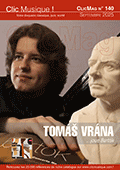 Les deux Quatuors pour piano et cordes de Mozart ont séduit des concertistes qui justement, avec des trios tirés de quatuors constitués, les ont joués comme des concertos de chambre, et même des chefs d’orchestre revenant expressivement au piano pour eux, Georges Szell et André Previn en sont les meilleurs exemples. J’aurais pu croire que le piano si distingué de Finghin Collins dont les albums Schumann m’avaient tant plu, s’entourant de ses amis, n’y serait point le soliste. Il ne l’est pas en fait, mais le caractère si fort de ses partenaires le place non pas parmi eux, mais devant eux, maitre d’une dramaturgie qui justement fait jaillir ces deux opus à l’espressivo si sollicité hors des limites du salon. C’est le Mozart le plus lyrique que Finghin Collins fait chanter de son dolce où sonne une touche pathétique dès l’Allegro du Sol mineur, et comme ses trois amis l’entendent, chantant comme lui, mais pas derrière lui en termes de présence sonore, d’inspiration. À eux quatre ils ne font pas du tout un quatuor, et plutôt une symphonie concertante, sombre et Sturm und Drang tout au long du Sol mineur, grand ton, grand soleil, plein air joueur pour le Mi bémol majeur, qui se donne ici des allures de sérénade, si bien que les deux opus se contrastent pour former le visage de Mozart, ce Janus de musique. Prise de son magnifique pour un disque parfait. (Discophilia - Artalinna.com) (Jean-Charles Hoffelé)  Mozart's Piano Quartets date from the mid 1780s – a period that also brought, among many other things, five of his major piano concerti (D minor K. 466; C major K. 467; E flat major K. 482; A major K. 488 & C minor K. 491), two important string quartets (including the Dissonance K. 465), and his opera Le nozze di Figaro. While there were earlier incursions by less well-remembered figures into the piano quartet repertoire, it took Mozart to raise its status on to an unprecedented plateau. In his two quartets he found a way of giving each instrument - violin, viola, cello and piano - its rightful sense of independence. According to the composer’s own catalogue, the K. 478 Quartet was completed on 16th October 1785 and was among a number of works requested by the Viennese publisher, Franz Anton Hoffmeister, who was also a composer. In it Mozart treats his four instrumentalists as equals, with the concerto-like piano part well balanced against the continuously interesting string writing. However, Hoffmeister, hoping for something to suit the amateur market, was dissatisfied with what Mozart submitted, complaining the music was too difficult and that the public would never buy it. He told the composer to write in a more popular vein or else he would neither print anything further of his nor pay him. The disgruntled Mozart responded, “Then I will write nothing more, and grow hungry or maybe the devil take me!” But he did write another Piano Quartet, completing it on 3rd June 1786. This time the more obliging firm of Artaria published it.
 |
